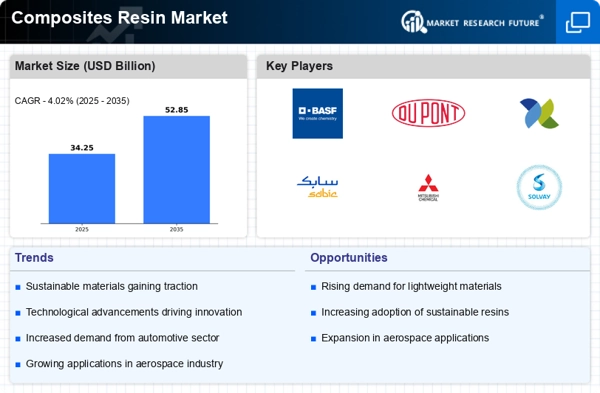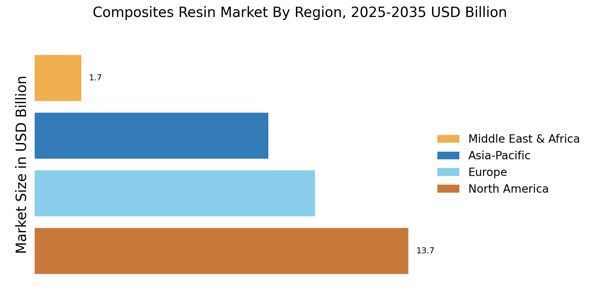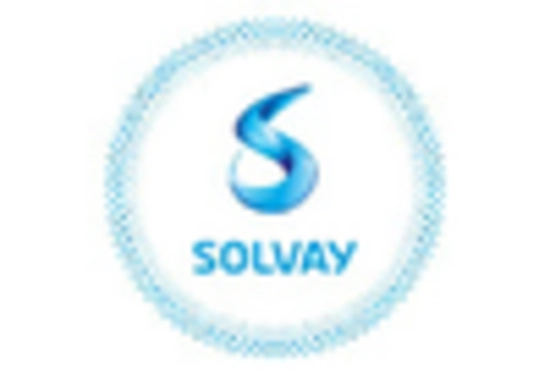Growth in Renewable Energy Sector
The renewable energy sector is emerging as a pivotal driver for the Composites Resin Market. Wind energy, in particular, is experiencing rapid growth, with composite materials being essential for the construction of wind turbine blades. In 2025, the demand for composites in the renewable energy sector is projected to increase by approximately 20%, reflecting the industry's shift towards sustainable energy solutions. The lightweight and durable nature of composites makes them ideal for enhancing the efficiency and longevity of wind turbines. Additionally, as governments and organizations prioritize renewable energy initiatives, the Composites Resin Market is likely to see a corresponding rise in demand, fostering innovation and development in composite technologies.
Rising Demand in Automotive Sector
The automotive sector is experiencing a notable surge in demand for lightweight materials, which is propelling the Composites Resin Market. As manufacturers strive to enhance fuel efficiency and reduce emissions, composites are increasingly favored for their strength-to-weight ratio. In 2025, the automotive industry is projected to account for approximately 30% of the total composites resin consumption. This shift towards composites is not merely a trend; it reflects a broader commitment to sustainability and performance. The integration of composites in vehicle design is likely to continue, driven by regulatory pressures and consumer preferences for eco-friendly options. Consequently, the Composites Resin Market is poised for substantial growth as automotive manufacturers adopt these materials to meet evolving standards.
Expansion in Aerospace Applications
The aerospace sector is witnessing a significant expansion in the use of composite materials, which is positively influencing the Composites Resin Market. Composites are increasingly utilized in aircraft components due to their lightweight properties and resistance to corrosion. In 2025, it is estimated that the aerospace industry will represent around 25% of the total demand for composites resins. This growth is driven by the need for improved fuel efficiency and performance in aircraft design. Furthermore, advancements in manufacturing techniques, such as automated fiber placement, are enhancing the feasibility of using composites in aerospace applications. As a result, the Composites Resin Market is likely to benefit from this upward trend, with increased investments in research and development to innovate new composite solutions.
Increased Investment in Infrastructure
The ongoing investment in infrastructure development is significantly impacting the Composites Resin Market. As countries focus on modernizing their infrastructure, the demand for durable and lightweight materials is rising. Composites are increasingly used in construction applications, such as bridges and buildings, due to their superior strength and resistance to environmental factors. In 2025, it is anticipated that the construction sector will account for nearly 15% of the total composites resin market. This trend is further supported by the need for sustainable building practices, as composites offer long-term cost savings and reduced maintenance. Consequently, the Composites Resin Market is likely to experience robust growth as infrastructure projects continue to expand.
Technological Innovations in Manufacturing
Technological innovations in manufacturing processes are playing a crucial role in shaping the Composites Resin Market. Advanced techniques such as 3D printing and automated layup processes are enhancing the efficiency and precision of composite production. These innovations are expected to reduce production costs and lead times, making composites more accessible to various industries. In 2025, it is projected that advancements in manufacturing technology will contribute to a 15% increase in the overall market for composites resins. As industries seek to optimize their production capabilities, the adoption of these technologies is likely to accelerate, further driving the growth of the Composites Resin Market. This evolution in manufacturing is indicative of a broader trend towards increased efficiency and sustainability.


















Leave a Comment